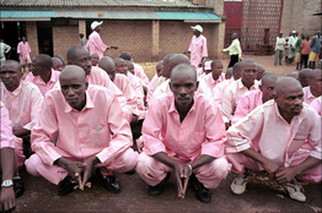Picking Up the PIeces
|
Paul Kagame will become in charge of the Tutsi military and head the RTWL rebels in 1994. He brings an end to the genocide and becomes the present of Rwanda. As president he will need to enact laws to bring this country that was torn apart back together.
Delivering justice for mass atrocities is a daunting challenge in any country, and the scale of the Rwandan genocide would have overwhelmed even the best-equipped judicial system. In Rwanda, the task was made more difficult by the fact that many judges, lawyers, and other judicial staff were killed during the genocide, and much of the country’s infrastructure was destroyed. Despite these challenges, the Rwandan government embarked on an ambitious and unprecedented approach to delivering justice, using both conventional domestic courts and community-based gacaca courts. By 1998, the total prison population had reached 130,00 for trails but only 1,292 people had been tried. It became apparent that it would take decades to prosecute all those suspected of involvement in genocide. So Rwanda used traditional "gacaca" community courts to try those suspected of taking part in the 1994 genocide. However the key individuals - particularly those accused of orchestrating the slaughter did appear before an International Criminal Tribunal in northern Tanzania. |
|
The perpetrators in pink jumpsuits are actually part of this process of moving on and were determined guilty by the gacaca courts.. While some of the worst offenders are spending their lives in prison, the Rwandan government came to the conclusion that giving harsh life sentences to all those involved in the genocide of 1994 would only deepen the grudge that caused the Hutus to take up arms against the Tutsis in the first place. To help encourage restorative justice in Rwanda, the Rwandan Government established a system of Gacaca courts, based on the traditional court system. Gacaca literally means “justice on the grass”, and in these village courts, perpetrators are cross-examined by the very communities in which they committed their crimes. Both perpetrators and victims are involved here, and the process is meant to simultaneously encourage repentance from perpetrators, and forgiveness from survivors. In this system, perpetrators are often encouraged to come forward and admit their crimes for a lesser sentence. Which brings us back to our prisoners in pink.
Perpetrators who are considered to be minor genocidaires are allowed to serve minimal sentences and be re-integrated into society, but must wear their signature pink jumpsuits during the re-integration process. This is symbolic of Rwanda’s approach to moving on; in order to live after a genocide, a nation must move upward and onward without forgetting the atrocities of the past. Living and working in a country where there has been a genocide in Stop and think Could you live side by side someone who took part in killing your family? How do you move on? If you were Hutu is there anything you can say to the neighbor you once persecuted? How does a community forgive and move on? Or does it? |
Economics
Has life gotten better in Rwanda? Are they considered a developed, developing, or not developed country? What areas do they still need to improve on?
Watch the video and go to the following links to explain how. Rwanda's Economy & Economic Freedom
Watch the video and go to the following links to explain how. Rwanda's Economy & Economic Freedom



